Marco Etheridge's Blog, page 13
March 4, 2018
Hunting Giant Frogs -- Part Two
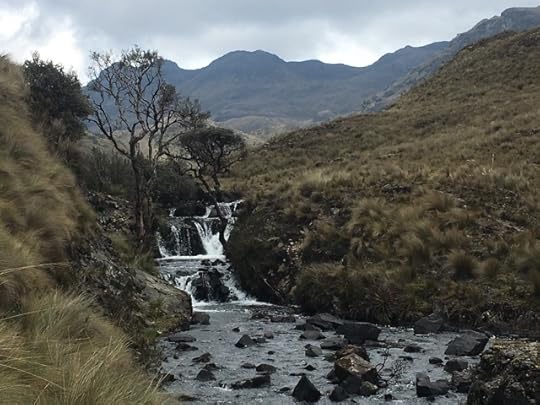
All rivers run to the Amazon
We left the high Cajas behind, dropping down the main road until we reached a tiny lane paved with rough cobbles. This kidney massager of a driveway was the path to Lake Zorrochucho, or, Laguna Llavinco (Take your pick). Three kilometers of butt-bangin brought us to yet another entrance to Parque Nacional Cajas.
Nestled in a U-shaped glacial valley, the lake is tucked into the eastern edge of the Parque. Even though we were still at around 10,000 foot elevation, the air felt nice and chewy. And wet, the air felt wet. The afternoon rain, a normal weather feature for these parts, was closing in on us. What better place to find the elusive Giant Andean Frog than an isolated lake in a national park on a rainy afternoon?
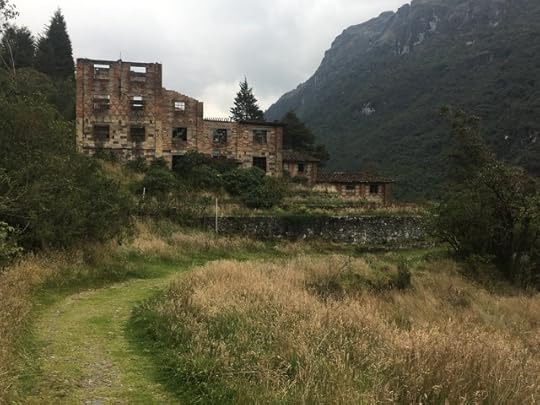
The old brewery
At the near end of the lake stand the ruins of an old brewery. The brewery was situated here to take advantage of the pristine waters that flow into the lake from the Caja. This lake is the source of the Tomebamba river, which runs right past my digs in Cuenca, two thousand feet down the valley. From there, the Tomebamba, like all the other rivers in this valley, makes the long journey to the Amazon.
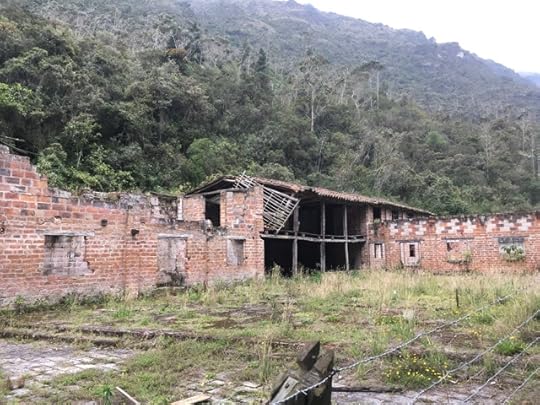
What's left of the brewery
The brewery is the reason for the cobbled lane. Beer wagons used to haul the Pilsner from the lakeside brewery and into the town of Cuenca. The brewery, started by a German family, has been shut down for decades, abandoned to fall into ruin. Alpaca are often seen grazing on the grounds, but they were absent this day. Perhaps the Giant Frogs had scared them off.
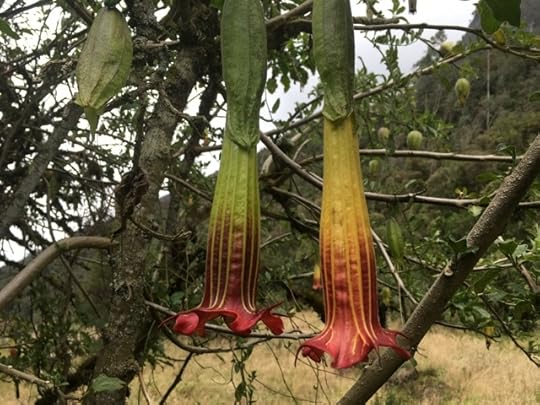
Angel's Trumpet
Growing along the edge of the lake was one of the seven varieties of Brugmansia, or Angel's Trumpet. The source of scopolamine, among other drugs, the blossoms of the Angel's Trumpet are used for all sorts of things. The seeds of the blossoms are dried into a powder, which is reputed to have the power to render a person compliant. Think of it as a zombie drug. There are wildly differing accounts as to the effects of drugging someone with scopolamine. It is real enough, however, to cause law enforcement and travel advisory websites to list it as one of the dangers of traveling in South America.
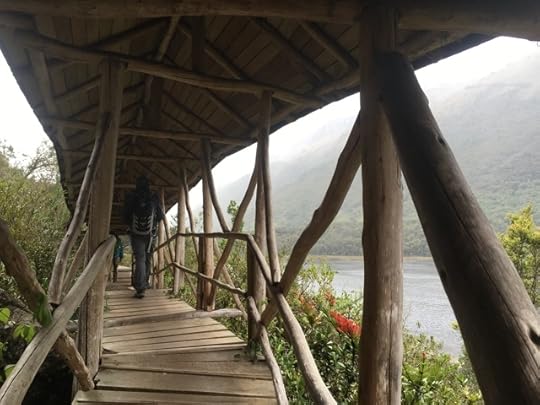
The Lake, the Walkway, but no damn Frogs
As we reached the far end of the lake, the rain reached us. The clouds pushed down to tops of the mountains, cloaking the entire valley in a wet, gauzy light. Running up the far shore of the lake is a covered walkway. We stumped along the walkway, grateful for the cover and the brilliant array of red and green bromeliads. The day had started as a brilliant, sunny, and breathless hike. It was finishing as a squishy, splashy, slippery hike.
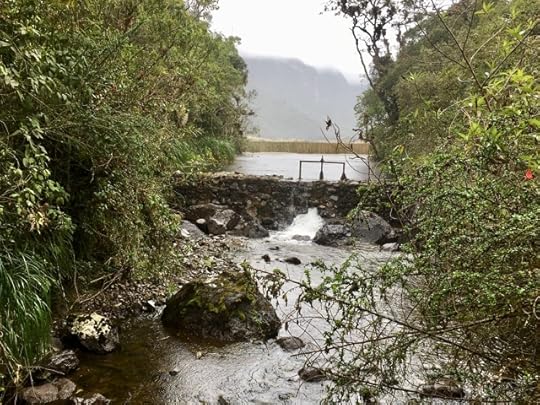
Reaching the dam at the low end of the lake, we had almost completed our circumnavigation. And still no Giant Frogs. This was our last chance. We peered across the reedy lake surface, under bushes, and next to likely-looking rocks. Alas, Alack, there were simply no Giant Frogs to be found. We didn't even see any normal-sized amphibians.
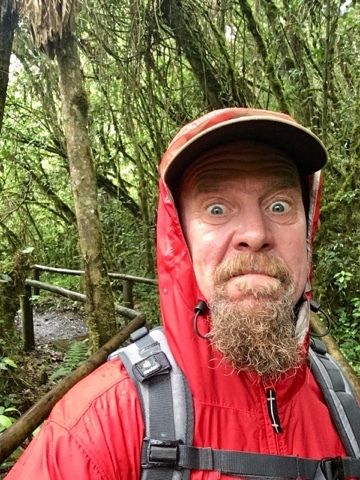
Wait! What was that?
Nope, no Giant Frogs. I could have felt short-changed, a victim of a wildly inaccurate hoax, but I didn't. It was a wonderful hiking day, a day full of grand vistas, crazy weather, weird plants, and great camaraderie. But I remain hopeful that the Giant Frogs exist. The world needs huge amphibians of unusual size (HAUS) if for no other reason than to go on wild-froggy chases looking for them.
Ah well, such is the life of the traveler. Be well, stay curious, and Ciao for Now!
PS: This still seems like it could be real, right?!?!?
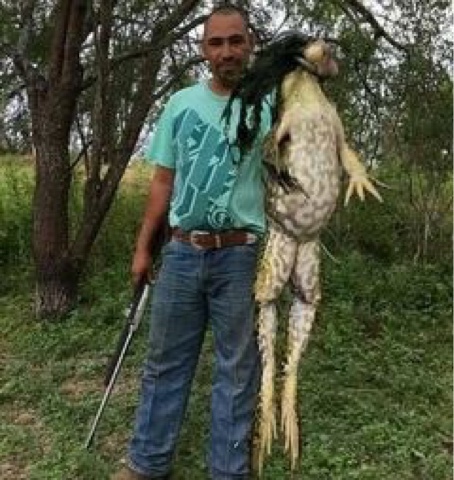
Published on March 04, 2018 05:38
March 2, 2018
Hunting Giant Frogs -- Part One
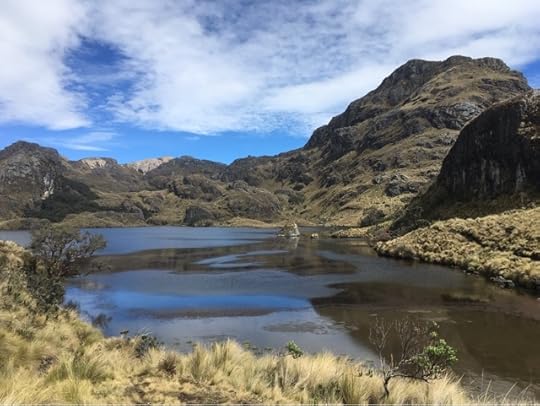
High in the Caja, the western spine of the Andes Mountains
Cuenca, Ecuador, sits in a valley between the eastern and western spines of the Andes. The city is at an elevation of about 8,300 feet above sea-level. Traveling over the top of the eastern spine of the Andes will drop one into Amazonia. Travel to the west, over the Cajas, and one will begin the very steep descent to the hot, wet, fertile fields that surround Guayaquil. Sprawling across the very top of the Cajas is the Parque Nacional Cajas. Steep Andean peaks climb towards the sky from the trailhead, which is perched at an elevation of over 13,000 feet above sea-level. The Parque is home to the Andean Condor, Coati, and a host of strange and rugged plants. There are other creatures as well, strange creatures. Giant earthworms burrow in the soils, worms that reach a meter in length and an inch in girth. And, supposedly, giant frogs.
With this wonderland close at hand, what could any hardy traveler do but set out for a hiking excursion? Fueled with a hearty gringo brekkie, we drove the forty-five minute climb up to the Parque. There is no entry fee, but all hikers have to register. The Rangers dislike packing out unknown dead gringos. Our goal was a strenuous hike, breathing the thin air at high altitude. Our hope was to get a glimpse, perhaps, of the mysterious Giant Frog.
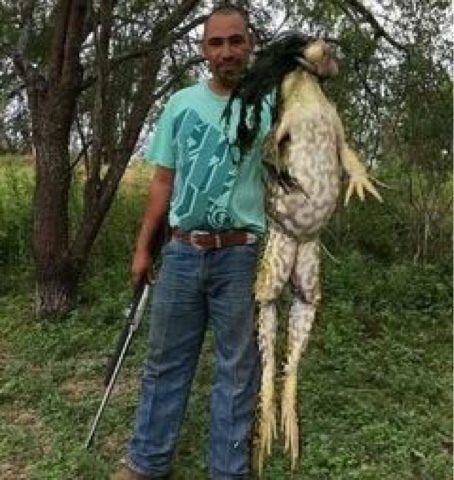
Giant Frogs!! From an image that appeared in a local news article.
Villagers claim that the giant frogs live in the valleys of the Caja. Big enough to gulp down a small dog, the gargantuan amphibians are a matter of some dispute. But what the hell, why not go look for a frog that could swallow Fluffy the Poodle? Big Foot, the Yeti, Crop Circles, Giant Frogs, any of these could serve as a good excuse for a romp. Fully-packed for the incredibly changeable weather, we set out along a narrow path that led through the vast open alpine landscape. The Caja has hundreds of lakes, some no bigger than a puddle. Most of the vegetation consists of ground-hugging sedges, hardy clump grasses, and rock-clinging lichen. Clouds sweep across the sky, bringing chill shadows. The shadows and sunlight compete to dapple the craggy mountains with ever-changing patterns of light and darkness. The air is thin, very thin. Climbing a steep trail is an effort.
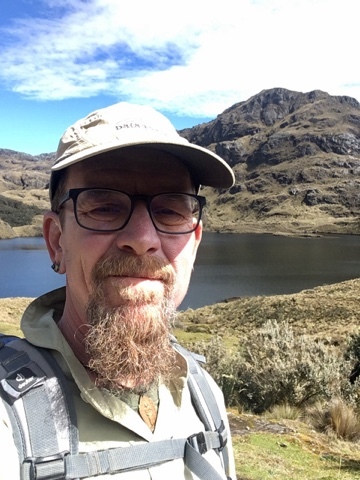
High in the Andes
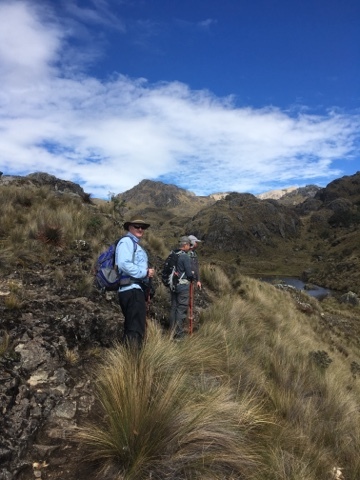
Gringos sucking thin air
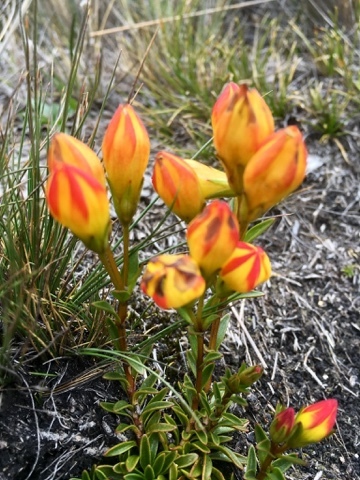
Living close to the ground
There is very little here that is tall save the rocky peaks. To survive the harsh conditions of this environment, plants hug the ground. There are tiny sedges everywhere, putting out small flowers that seem to be afraid to show themselves. The flora amongst the rocks is best viewed by getting down on all fours and crawling around. It is also, I suppose, a good way to find a giant frog. If you happened to be looking for one.
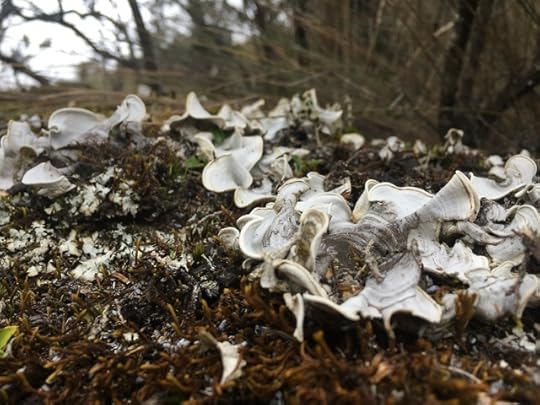
Life clinging to the rocks
Puffing like good little locomotives, our merry band of four rounded the first lake. The sun baked down on us as we gulped at the rarified air. Over one rise, then another, we climbed slowly. Ahead of us was one of the few pockets of larger vegetation, the paper-tree forest. Tucked into a cleft at the base of a sharp peak, the entire forest covered only few acres. The trail plunged into the thin, twisted trees. Surely, if there we were going to encounter mysterious creatures, this would be the place.
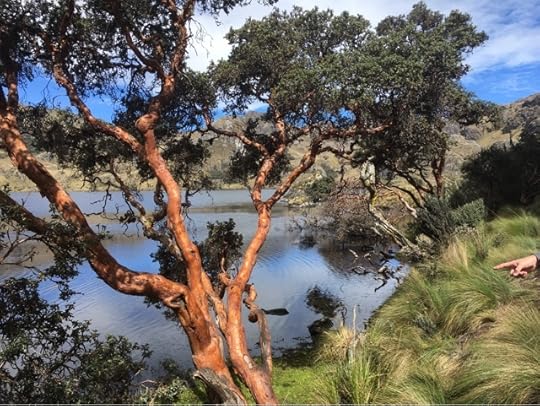
Wait, what is that disembodied human hand doing there???
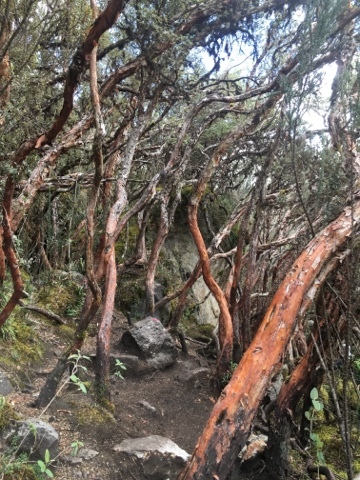
The trail through the paper-trees
Alas, I cannot report sighting any giant amphibians. There was, however, a slippery descent through the munchkin forest and into the next draw. The trees made dandy handholds on the muddy trail. As we emerged from the tangled trees, the vistas opened up again. The clouds were building, cloaking the lakes and mountains in an ever-changing panorama.
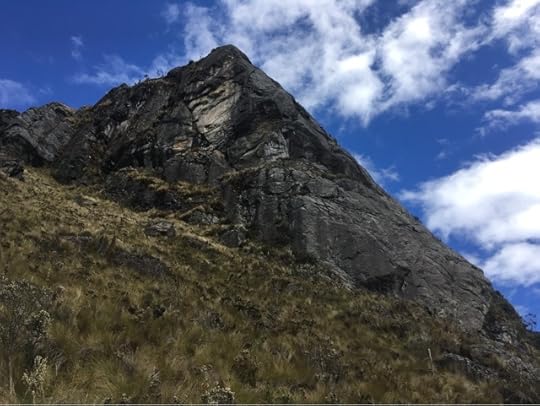
First there is sun...
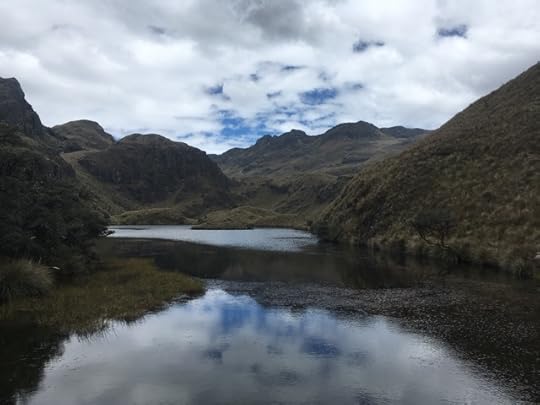
Then clouds...
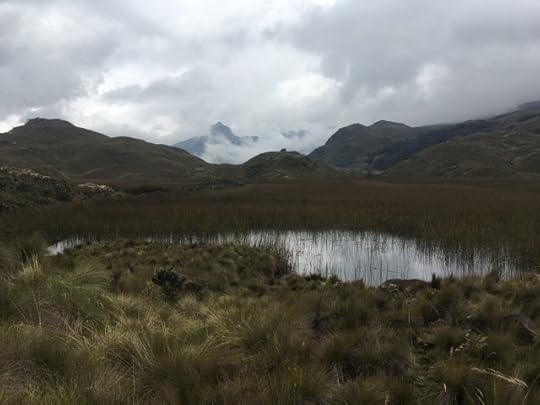
And then one is in the clouds.
Between the jutting peaks of rock lies a watery landscape of grassy hummocks, sedge filled streams, and myriad lakes. Tiny trout dappled the surface, little flashes of silver that burst out of the water in search of an insect. Some of the lakes were blue mirrors, while others were choked with reeds.
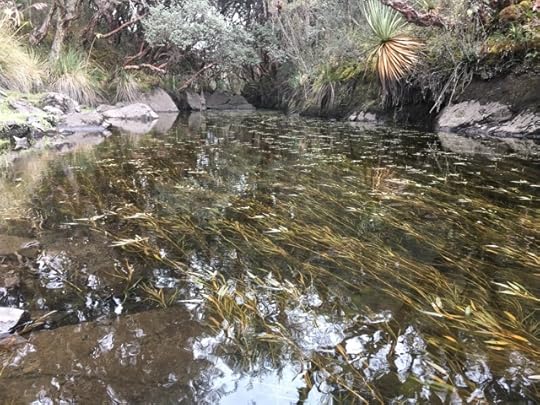
Water plants and sky
We hiked a long loop past three of the main lakes. The clouds were winning the battle against the sun, pushing the warmth out of the air. Layering up with warmer clothing, we continued our loop, circling back towards the narrow highway the crosses the Parque.
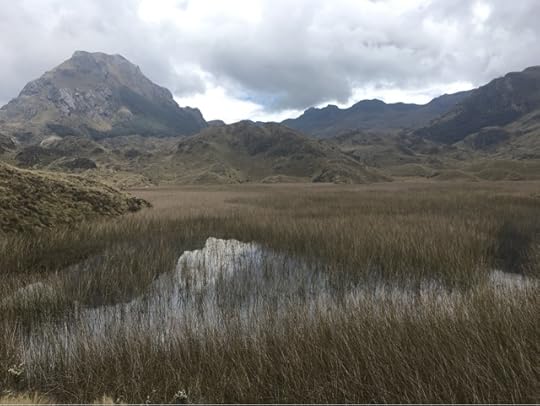
A wonderland of rock, water, and sky, we edged along the last reed-filled lake. Though our loop was only five miles or so, it was no small effort trying to suck oxygen out of the miserly air. We had not seen any Giant Frogs, but it had been a great walk. But wait! There is another Parque de Nacional close by! Even as the clouds closed in, bringing a very palpable threat of rain, we decided to continue our hunt. Perhaps there was still hope. We stowed our gear in the bed of the truck and piled into the cab, eager to continue the adventure.
We did make it to the next park. We did hike in an isolated valley that forms its own micro-climate. But whether of not we were eaten by huge, blood-thirsty Andean frogs is the stuff of the next post. Until then, Dear Readers, travel often, travel well, and Ciao for now!
Published on March 02, 2018 17:45
February 25, 2018
Random Cuenca
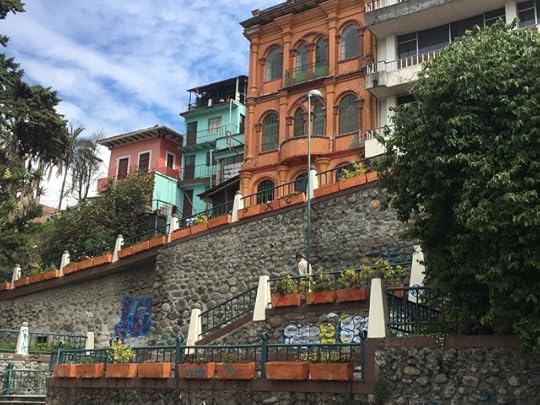
Cuenca, Ecuador via walkabout
Cuenca is a land of perpetual springtime. Situated in a valley between the two spines of the Andes Mountains, the city is perched at 8,300 feet above sea-level. The urban area has a population of about 500,000. Folks have been living here for a very long time. The first inhabitants were nomadic hunters. The Canari people settled in the valley, forming a civilization that lasted until about 1470, when the Canari were conquered by the powerful Inca empire. The Spanish Conquistidores arrived here around 1550, defeating the Inca and establishing Spanish colonial rule. Cuenca achieved independence from Spain on November 3rd, 1820.
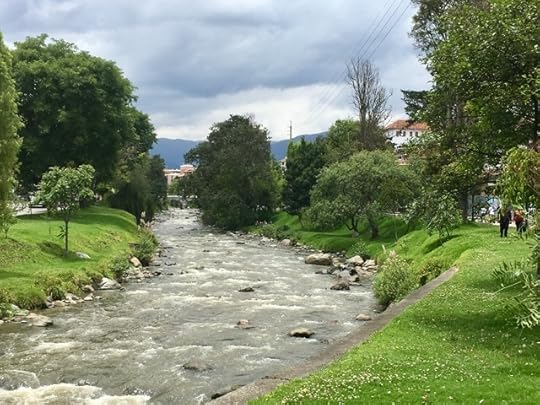
Rio Tomebamba
Cuenca gets its name from the Spanish word for a joining of rivers. Four main rivers converge in the Cuenca basin. Senor Hansen, my host, lives on the Tomebamba. The frequent heavy rains in the Caja, the mountains above the city, can turn the Tomebamba into a raging torrent in a matter of minutes.
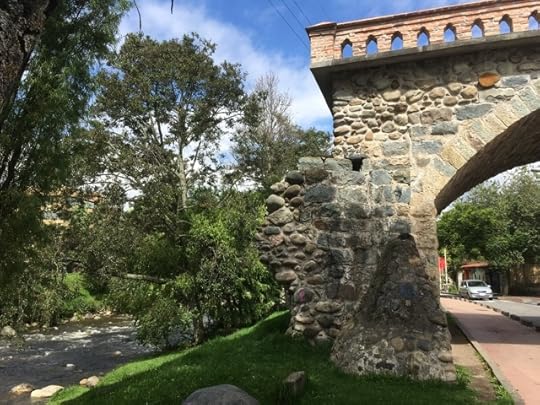
The Puente Roto, or Broken Bridge. The old bridge did not survive one of the flood events on the Tomebamba.
Today, the historic center of Cuenca is a UNESCO World Heritage Site. The more modern portions of town lie outside the Heritage Site boundaries. The city is popular with Ex-Pats, mostly from the USA. The mild climate, reasonable healthcare, and Ecuador's lenient attitude towards Gringo retirees, contribute to the flow of Ex-Pats. There are between three and four thousand of them here, although estimates vary. As a result, there are numerous restaraunts and businesses that cater to the Ex-Pats.
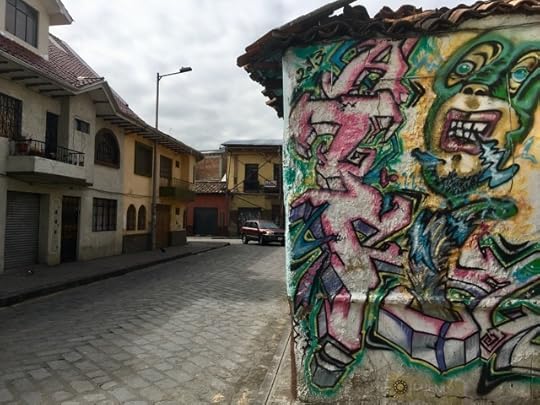
Cuenca is a great city for Walkabout. Stray just a bit off the diesel choked main routes, and one will find peaceful walking on narrow flagstoned streets.
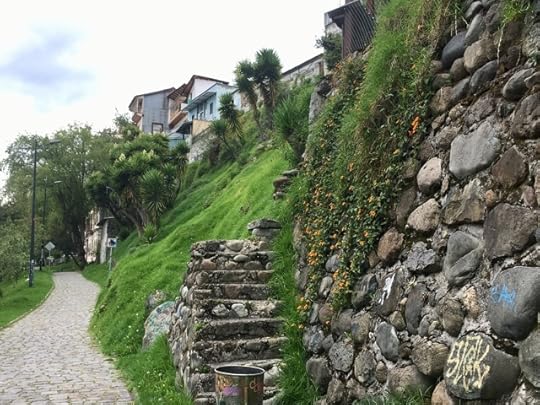
There are long walks along the Rio Tomebamba, with the historic center of Cuenca rising on the east side.
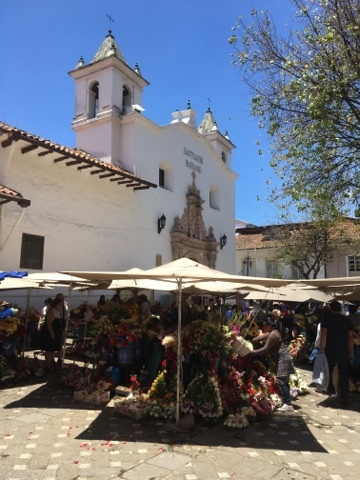
The flower market in one of the many plazas of the city.
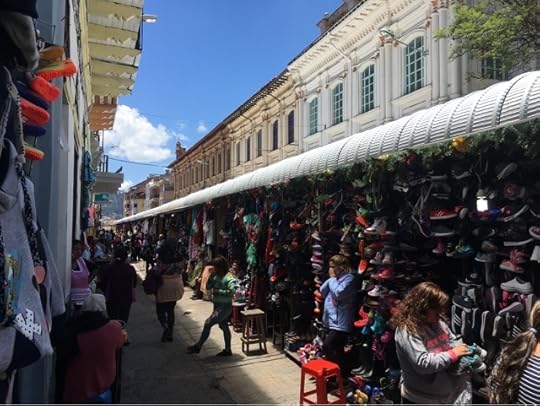
If you want to get your shopping fix, the many market stalls have you covered. For serious food shopping, the Mercado, the enormous covered market, has hundreds of stalls selling local food and produce. If a traveler needs fifty different kinds of potatoes, the Mercado is the place to be.
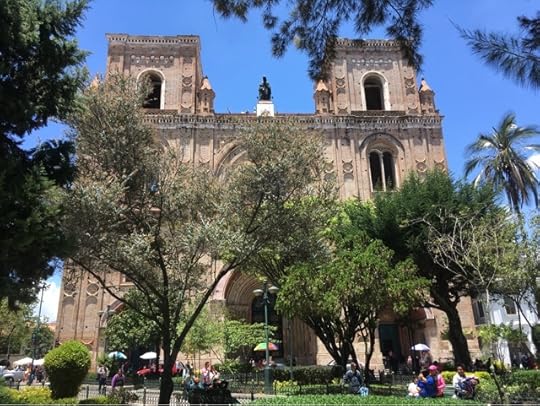
And, of course, there is a Cathedral on the main plaza.
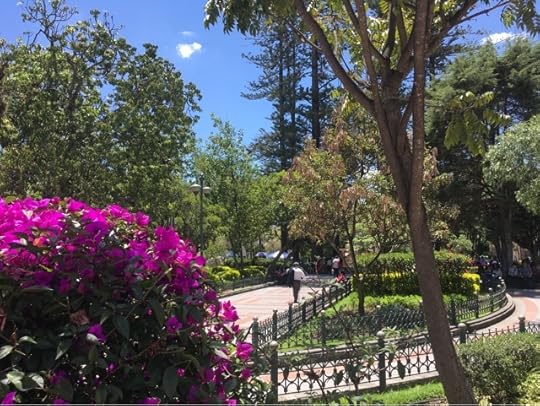
The central plaza, complete with statues of The Dead Heroes.
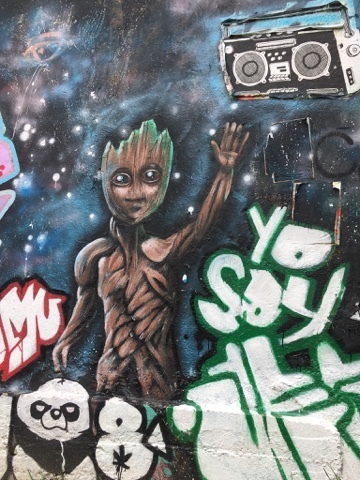
Cuenca Graffitti
This is the base of operations for the rest of this sojourn. In truth, I am being lazy, enjoying the luxury of warm hospitality, a great host, and a room of my own. I sit on the balcony and watch the Tomebamba. I try to coax the hummingbirds to eat out of my hand. I go walkabout. I enjoy feeling like a younger man simply by comparison with the average age of the Ex-Pats. Life is slow and easy. I'm okay with that.
So, from Cuenca, Ecuador, it is time to say "Ciao for Now!"
Published on February 25, 2018 09:10
February 24, 2018
Onward
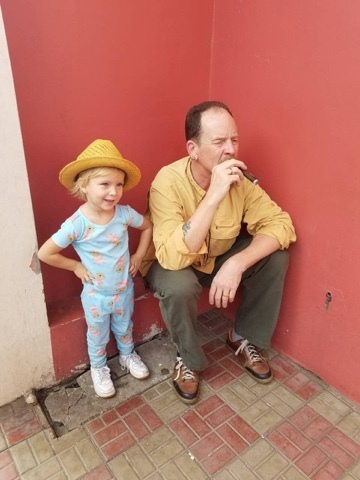
Bags were sorted, brekkie consumed, and the Bozo Bus loaded. Adios Esteli, it was the long downhill run into Managua and the Agusto Sandino Airport. The mountains fell away as we descended, dropping down into the flatlands. Fruit stands appeared along the Pan-American Highway, vendors sprinkling the space in front of their stalls to ward off the dust of the day.
All too soon it was time for hugs and goodbyes as the Bozos and Bozettes dispersed for flights to here and there. My compadre and I were the only Bozos flying south, bound for Ecuador. At the security checkpoint I was compelled to donate a few cheap lighters and a cigar cutter. These implements had passed through security in three different countries on three continents, but no matter.
Nicaragua being what it is, there is a comfy cigar lounge in the terminal. Talk about civilized. With time to kill, we held another impromptu gathering and herf session, whiling away the time to boarding. My illustrious compadre, Senor Hanen, had upgraded us to business class. We were in no hurry. Ah, the luxury of special treatment, drinks before departure, and ample seating. It is temptation of the worst kind. Get thee behind me, Satan! I enjoyed it while it lasted.
Managua to Panama City, then Panama City to Guayaquil, all without issue, Easey-Peasy. There was one last hurdle, a bit of customs law that we were attempting to ignore. Ecuador grows some of the best tobacco leaf in the world. Most of the tobacco is grown specifically for cigar wrappers, the most costly part of any cigar. Despite extensive tobacco farming, Ecuador lacks a cigar culture. They get very frowny-faced about folks bringing cigars into the country. The official limit is twenty-five cigars per person. Both of us were well north of that limit. Somewhere on the order of Nome, Alaska, north of that limit. Orders of magnitude north of the limit. As we handed over our passports at customs, I put on my best Village-Idiot expression. When asked if we were traveling together, I blurted out "Yes!" Senor Hansen blurted out "No." I gave him a hugely over-acted look of deep hurt, then turned back to the two customs guys with an vacant idiotic grin. The official gatekeepers shook their heads and motioned us through the open lane, into the freedom of the Guayquil airport. Sometimes being more trouble than one is worth is the ticket. This day it paid off in spades.
We were met at the airport and driven to our Guayaquil digs. Our host was a friend of Senor Hansen, and our accommodations were palatial. Guayaquil was hot, wet, rainy and steamy. We whiled away the evening with fine cigars and good conversation. A steady rain dappled the surface of the swimming pool. Life was grand.
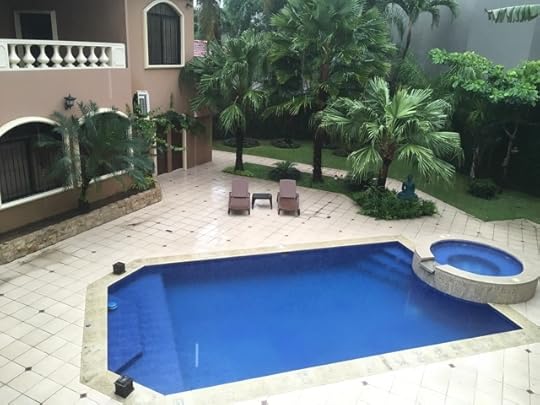
Spoiled, I am being spoiled!
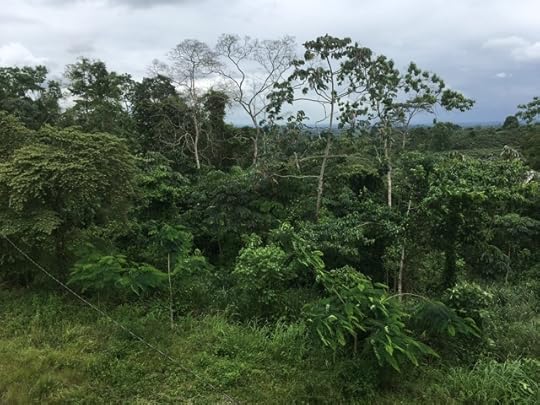
After a fine breakfast and a farewell cigar with our coffee, it was time to hit the Ecudorian road. Guayquil is the largest city in Ecuador, a sprawling metropolis and port city. It sits amidst converging rivers and a swampy coastline, a steaming flatland of fruit farms and jungle. As we drove out of town, I saw cemeteries with above-ground mausoleums stacked like shoe boxes. Dead folks have to remain above ground. Plant a corpse in a traditional grave and the ground water will pop them out of the soil like a zombie champagne cork.
We drove past myriad fruit stands, each sporting a wild assortment of tropical delights. From melons to mangoes, dragon fruit to papaya, it was a frugivore's paradise. Leaving the fruit plantations behind us, the road turned toward the Caja, the westward spine of the Andes. The drive to Cuenca led over the pass at Tres Cruces and an elevation of 13,500 feet above the sea-level we were leaving behind.
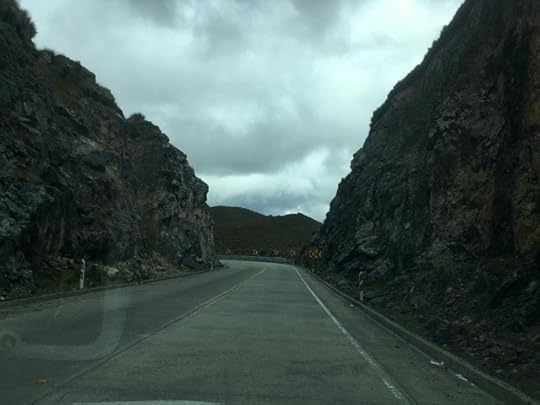
Climbing the Caja.
It's a long, slow grind up the Caja. The road is subject to frequent washouts, fog, and blinding rain. Today we had only washouts, fog, and moderate rain. The lower slopes of these mountains are bathed in an almost perpetual fog as the heavy wet air off the Pacific slams into them. Trucks and buses grind up the steep climb, or burn up their brakes threading their way down. It is not a road to be taken lightly.
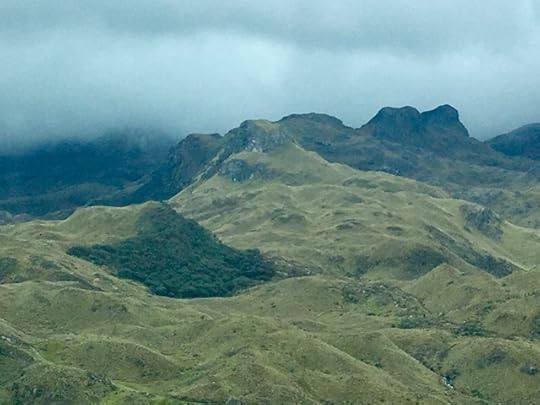
Nearing Tres Cruces, 13,500' above sea-level.
We broke clear of the fog and rain just below the last climb to the pass. From here on, we were treated to wide views of the Andean highlands. The highlands are dappled with many small lakes, sedgegrass, and wild llamas. The weather is as unpredictable as any place on earth, changing from bright sunshine to freezing sleet without warning. It is wide, vast, and empty.
The road drops from Tres Cruces into Cuenca, our final destination. At 8300' above sea-level, Cuenca is the third-largest city in Ecuador. A UNESCO World Heritage Site, it is a city of perpetual springtime. It is also home to a sizable Ex-Pat community, some three to four thousand of them.
Home again, home again, jiggety-jig. We trundled our bags up to Senor Hansen's apartment, glad for the long ride being done. Ensconced on the balcony with coffee and cigars, we would travel no more for the nonce, content with where we are.
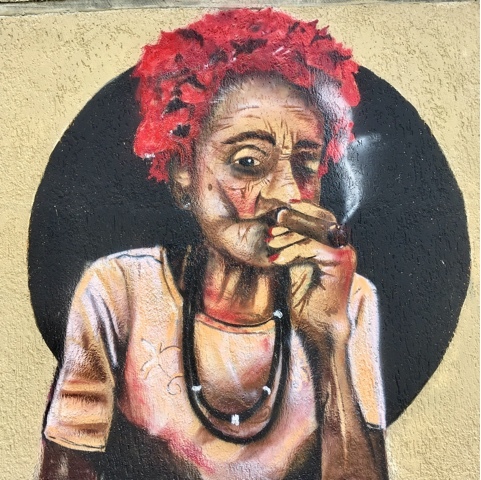
Santa Honaria.
The patron saint of traveling cigar smokers, Santa Honaria, had watched over our comings and goings. There will be more to come in Cuenca, but that is the stuff of another post. As always, travel often, travel well, and Ciao for Now!
Published on February 24, 2018 12:45
February 22, 2018
Blending it Out
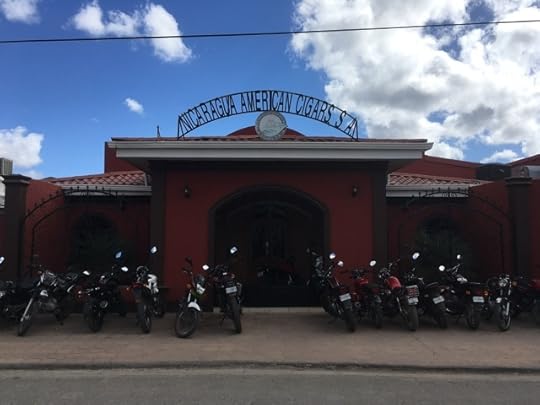
Cigar Factory, Nicragua
Through the magic of Blog-Time-Travel, the lucky reader is able to be in two or more places at the same time. Any Bozos reading this post may experience a slight dizziness as their reality collides with the blog time-warp. It will be okay. Place a brown paper bag over your head, then place your head between your knees. You won't feel any better, but it is bound to improve the days of those around you.
Cigars! It's all back to the cigars! And Rum! And debauchery! Whew, okay, here we go.
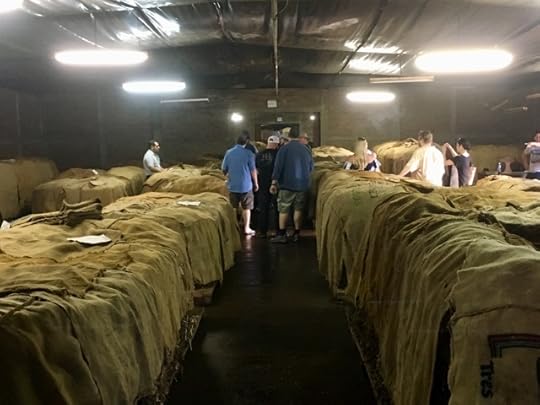
Some of cigar tobacco ends up in the slow lane. That's the leaf we like. The tobacco leaves pictured above have been dried in the drying barns, cured in pillions for up to fourteen months, and are now being finished in pillions at the factory. This tobacco may be two years old by the time it is rolled into a cigar. The goal of all this aging and curing is to bring out the sugars and oils in the tobacco. It is a long, slow process.
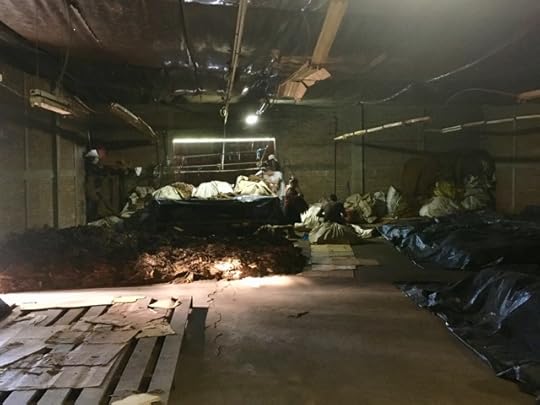
Re-wetting the leaf for slow aging.
Over the course of several days, both backward and forward in time, we dove back into the world of cigars that makes up Esteli, Nicaragua. At one factory, we smoked single leaves of tobacco, each taken from a separate priming on the plant. The differences in flavor and aroma were very discernible. This is how cigar blenders choose tobaccos for a cigar. Depending on the soil, the sunlight, the elevation, and even the priming on an individual plant, the tobacco leaves develop distinct flavors and aromas. These unique characteristics, when properly blended, form the basis of a great cigar.
We toured one of the largest tobacco brokers in Esteli. These folks buy, cure, age, and sell tobacco. If you are a small cigar manufacturer in Esteli, chances are you get you tobacco from a broker. There are more than fifty cigar rolling factories in Esteli. Some of the finest cigars made in this town are rolled in factories that are too small to have their own tobacco curing rooms.
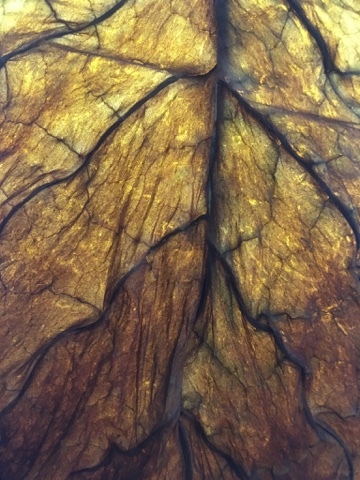
It all comes down to the leaf.
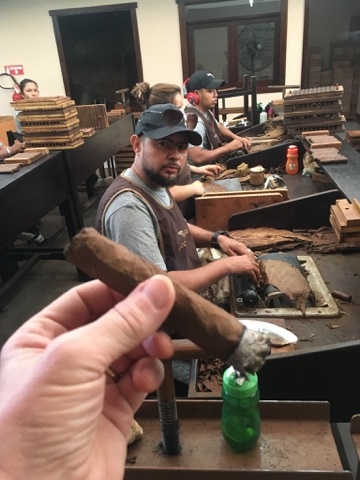
Smoking a freshie right off the table.
When the leaf is finally ready for production, it winds up on the rolling floor. The rolling process is usually done by a pair of people, the Bunchero and the Rollera. And, yes, the bunchers are usually men and the rollers are usually women. The Bunchero bunches carefully proportioned tobacco into his hand. The bunch then goes into a Liebermann machine atop a binder leaf. This is visible in the photo above. The flap of the Liebermann goes over and back, rolling the binder around the bunch. A dab of vegetable gum keeps the binder from unwrapping. The completed bunches go into a compression mold (top right and left background above) where they remain for at least an hour.
The Rollero is the person that puts the finishing touches on the stick. Popping the bunches out of the forms, the roller applies the wrapper, the specially treated tobacco leaf that will be visible to the consumer. The wrapper is often the dominant flavor component of a cigar as well as the final "skin" of the stick. The roller, as if by magic, rolls out a leaf, cuts it to size, flicks her hands, and presto-chango, the wrapper is on. A few more magic twirls and she cuts small circles of tobaccos for caps. The caps are applied to the end of the cigar, the stick is trimmed, and the completed cigar is stacked on the front of the table, ready for the roving Quality Control folks.
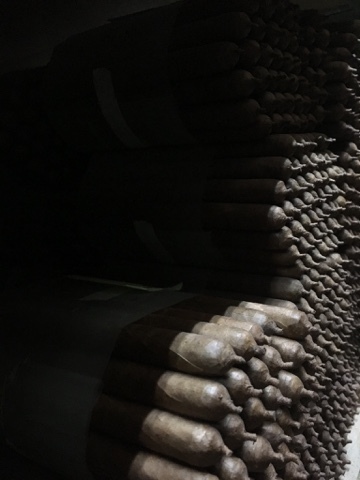
Cigars are aged yet again after rolling. This allowed the last of the ammonia to off-gas. Ammonia is the natural by-product of the fermentation process, the process that releases the oils and sugars that give the tobacco its complex flavors. Once the cigars are judged to be ready, they are banded, boxed, and readied for shipping. Almost every step of this process is done by the human hand, including applying the decorative cigar band.
Well before any production begins, there is another crucial step in crafting a cigar. This is the highly-subjective and arcane art of blending a cigar. At this point, some folks may scoff. "It's just a cigar." That is the same as saying "It's just wine." We wish these Philistines a lovely journey to a place far, far away from ourselves.
Tobacco from Esteli is know for it's strength and peppery spice. Esteli Ligero, the leaves cut from topmost priming on the plant, are prized for adding strength to a cigar. Jalapa leaf, grown in a valley to the north of Esteli, is know for imparting sweetness to a cigar. In addition to flavor, cigars must be blended for combustibility. Too much Ligero and a cigar won't burn properly. Seco leaves, the lowest priming, are less flavorful, but add combustion. So it goes, balancing flavor, strength, and proper construction. The master blenders, the folks that can put together a great cigar, these are the rock stars of Esteli. It takes a long time and a lot of work to become a master blender. Now we were going to take a crack at it.
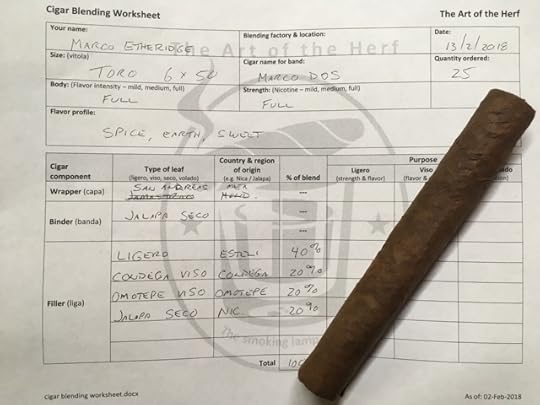
One of the great events of our Bozo Cigar Tour is the chance to blend our own sticks. Master blenders don't often reveal their secrets, but I ain't no master. As my worksheet says, I was going for Spice, Earth, and Sweet. The Bozos and Bozettes fine-tuned their blends under the expert tutelage of our guide, Colin Ganley, and Sergio Plasencia of the Plasencia Factory. This was the second rodeo for most of us. Once the blending was down on paper, one of the senior rollers crafted the stick on the spot, a freshie that had to be smoked within twenty-four hours.
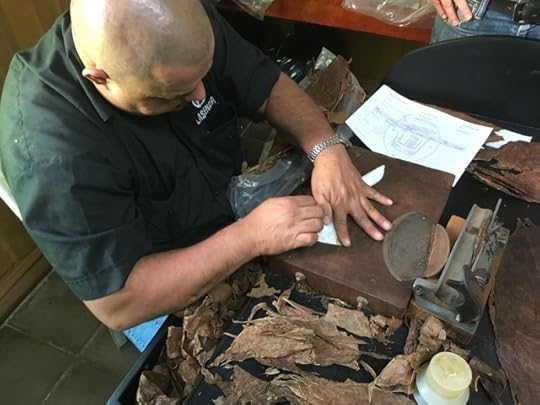
The "Marco Dos" cigar comes to life.
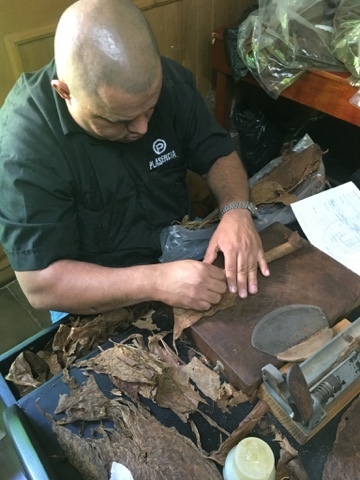
The wrapper goes on and, Ta-Da! It Lives!!
The good folks at Placensia are willing to produce bundles of our cigars for a smallish fee. Most of the Bozos and Bozettes ordered at least one bundle. I certainly did. The drawback is that these are fresh cigars. They will need to age another six months to achieve a really smokable state. Thus is is an excercise in delayed gratification. I was, however, able to smoke my freshie. A fresh stick always strikes me as pungent, with the flavors more distinctly noticeable, rather than blended and harmonious. Think of a new wine. Smoking a freshie is still a good indication of what the final product will taste like. I was very happy with the results. I look forward to August of this year, when I can sample the final product.
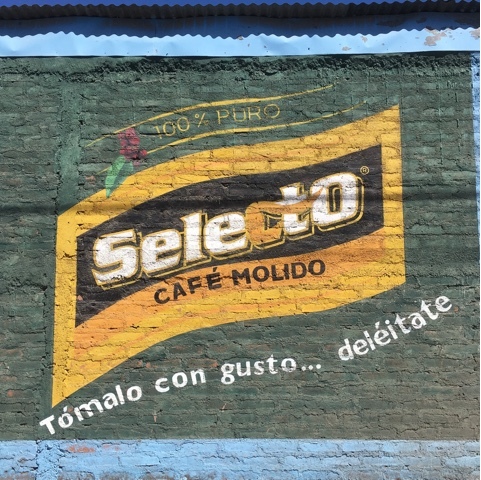
The cigar days done, our time in Esteli was drawing to a close. But we were not quite finished, not dead yet. There was time for walkabout, for a last dinner, and one last bout with the Nicarguan Rum. Songs were sung, cigars were smoked, and spoils divided. Zee Germans had departed Esteli, but we made up for their absence with some of the rock-stars of the cigar world. The party went far later than a feeble old man such as myself could handle.
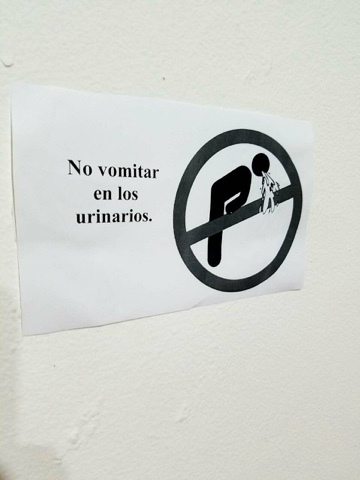
A cautionary sign at Hotel Los Arcos
Tomorrow would be the long bus ride to Managua, the rigors of the Augusto Sandino Aeropuerto, and the Bozo departure. In the meantime, I burrowed deep into my bed at the Los Arcos. Earplugs warded off the noise of the late-night revelry and I slept the sleep of the dead.
Published on February 22, 2018 06:14
February 21, 2018
Commodities
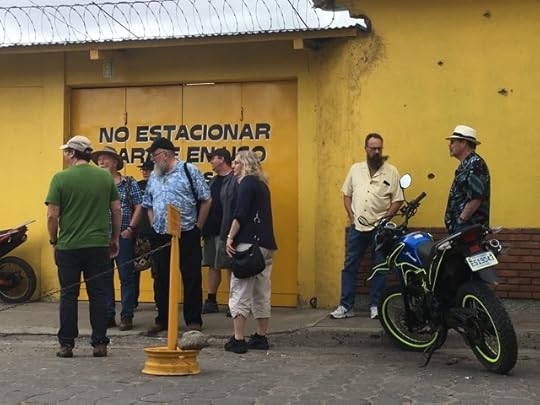
Bozos and Bozettes in the wild
It was a day to leave the tobacco fields behind. We boarded the Bozo Bus, traveling west and then south. Our destination was Matagalpa, the heart of Nicaraguan coffee country. The town of Matagalpa is perched at an elevation of 2,300 feet. Rising on all sides are the steep slopes of cloud forests where coffee is grown. Below the town, in the sun-baked lowlands, are the Beneficios. At the Beneficios are the huge drying patios where wet coffee beans are sun-dried, sorted, and bagged.
Coffee fruit are harvested by hand, processed, and washed at the farms. The wet beans have to be transported to the drying patios before the beans begin to mold. The beans have to be on the patios within twenty-four hours of coming out of the soaking tanks. It is harvest time in Matagalpa. Rickety trucks chug up and down the steep hills, each laden with a full load of wet beans. The heavy bags are carried from the trucks by hand, thrown down on the patio to break them open, then the beans are raked out flat. Almost every step of the process is hard physical labor.
The Bozo Bus labored up the steep slopes above Maltagalpa while the beans made their journey down the mountain. We passed an old Soviet tank on the side of the road, a reminder that this area was yet another battlefield during the Sandanista Revolution. The coffee farm that we were traveling to has been subject to the tides of that war. The land was taken from the owners following the revolution. One member of their family was murdered (or assassinated) in Managua. Eventually, they were able to recover about thirty percent of their farmland.
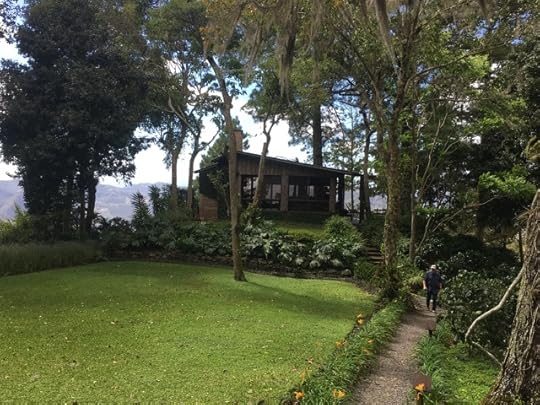
Our oasis in the Cloud Forest
Leaving the bus to fend for itself, we climbed the manicured pathways to the guesthouse. Perched on the top of the mountain, there are sweeping views of the valleys below. Clouds swept over the mountaintop, drenching everything with a fine rain. Sun, clouds, rain, more sun. Welcome to the cloud forest, and the nurturing cycle for the coffee that is grows under the shade canopy.
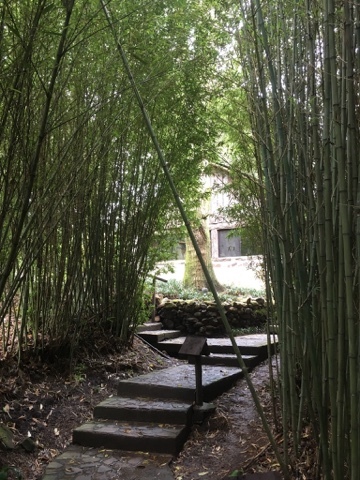
HIdden paths
We smoked, we lounged, we ate, we talked. It was a day for lazy reflection and conversation. When the rain blew in, the hearty few huddled under cover while the rest retreated to the warm fire burning in the guesthouse. Some of us even worked a bit.
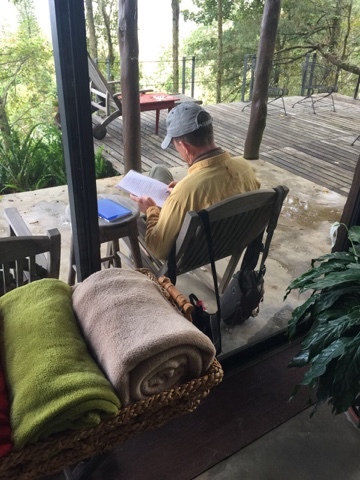
Scribbling above the clouds
But all was not fun and games. After lunch it was time for coffee cupping. The process of coffee cupping is a slurpy, noisy affair. The ground coffee is dumped in a cup, water of the correct temperature is poured over the coffee, and the process begins. First comes the sniffing of the coffee samples, then breaking the "crust" of floating grounds, then the slurping of coffee from spoons. This is the method coffee tasters and buyers use for determining what beans they will purchase.
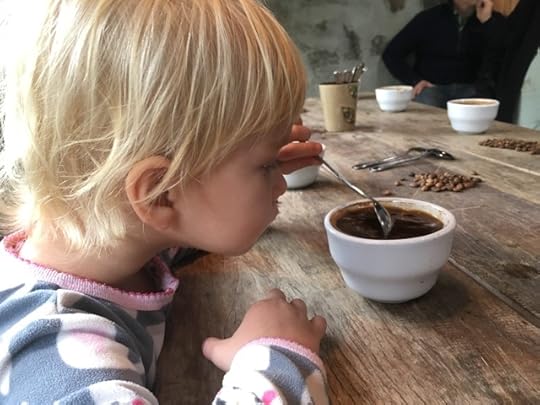
The world's youngest coffee expert.
Some folks trooped off to see the farm and its processing shed. The rest of us took on the task of being lazy sods. Regardless, I believe a good time was had by all. It would be difficult to not enjoy oneself in such an idyllic setting. Even the crapper had an expansive view.
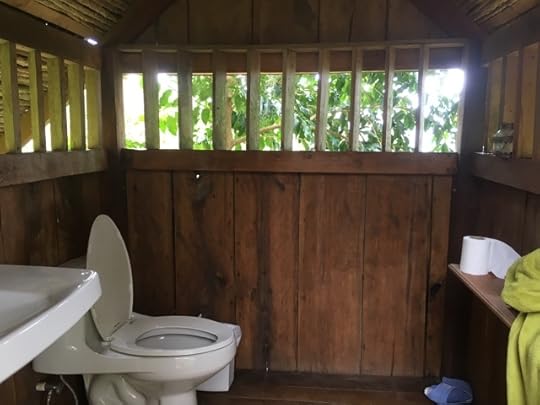
In the running for Great Toilets of the World
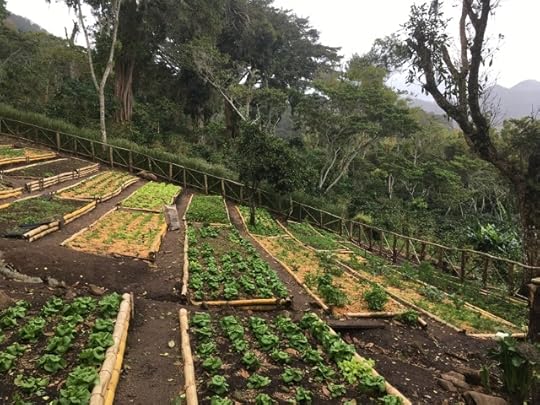
Coffee is not the only crop grown here.
Eventually we had to depart from our perch in the clouds. The bus ride back to Esteli included a long discussion on the commodity of coffee, including the state of workers, farmers, and coffee brokers. We weighed the merits of Free Trade, coffee co-ops, and the like. While the discussion ranged here and there, my thoughts turned to the basic commodity model of colonialism.
From my point of view, the colonial system serves a very simple purpose. A richer and more powerful nation takes over a poorer and weaker nation. The colony established, the colonizer tries to extract all of the moveable resources of the colony at the cheapest possible cost. The colonial power reaps the benefits of the commodities, and the colonized people suffer. The inhabitants of the colonized nation or region become the cheap labor that performs the extraction of resources.
Prior to the 'discovery' of the New World, the good folks of the Old World did not have coffee. How the hell they woke up the morning is still a matter of historical debate. Along with cacao (as chocolate) and tobacco, coffee would have a dramatic effect on the colonizer.
Coffee houses sprang up in Merry Olde England, which was not so merry at the time. By the early 1600's, coffee houses were gathering places for disgruntled citizens who had enough money for the luxury of the brew. The royalists were pissed off at the parlimentarians and vice versa. The opposing sides would gather at their respective coffee joints, get jacked up on caffeine, and proceed to foment political plots. The result was the beheading of a king, the rise of Cromwell, and a good old English Civil War. While all these events may not be directly attributable to the availability of coffee, there are many historians who include coffee as a contributing factor. Take that, you pesky Colonizers!
Here is simple experiment: Try to get a decent cup of coffee in Nicaragua. It is very difficult to do. The beans that are left for domestic consumption are the dregs of the crop, the grades that no foreign buyer wants. Almost the entire Nicaraguan coffee crop is exported to foreign markets. What is also exported is the lion's share of the value inherent in the commodity of coffee. Once the unroasted beans leave the country, all of the value stored in the commodity goes with them. The profits that come from brokering, shipping, roasting, packaging, wholesaling, and retailing the beans, benefit the importing countries.
Jumping up on the Reverend Squeaky-Eye soap-box for one short paragraph, I will perform a quick rant. If you care to make a difference in the way commodities you consume are extracted from other nations, do your homework. One can, for example, purchase and consume coffee that is roasted and packaged in Nicaragua. In doing so, you support the Nicarguan folks that ship, roast, and package the coffee. You help create jobs for Nicaraguan folks that produce the packaging. In other words, a larger percentage of the inherent value of the commodity of coffee stays in the country of origin. Thus endeth the rant.
The Bozo Bus chugged into Esteli. Dinner was consumed, and Zee Germans were re-engaged. The night was long, the rum beleaguered, and dead soldiers accumulated. I retired before the finale, but from the collective suffering apparent at the next morning's breakfast, the rum wars were fought to a draw. It was a lucky thing for the battered celebrants the day to come was a free day, a day without agenda, a day for nursing a wicked rum battering.
From the infamous Hotel Los Arcos, Esteli, Nicaragua: Ciao for Now.
Published on February 21, 2018 13:22
February 20, 2018
Esteli without Cigars
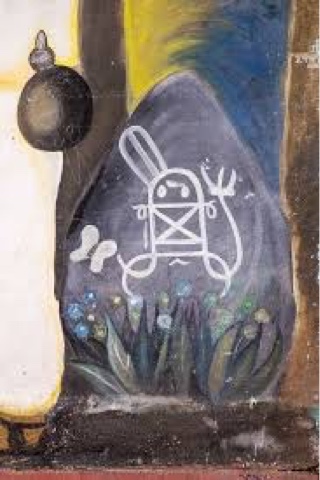
El Brujito, the Shaman emblem of Esteli, Nicaragua
Okay Blogger Boy, try to do a complete post without mentioning cigars. I dare ya, I double-dog-dare ya! Challenge accepted you rotten voice-in-my-head. (Psst... They're reading this. Oh, right, sorry. Ahem.)
Villa de San Antonio de Pavia de Esteli is the full name of Esteli. Through the town runs a river of the same name. On the far side of the river, folks discovered a series of prehistoric petroglyphs chipped into large rocks. One of these, now named El Brujito, was adopted as the official emblem of the city of Esteli.
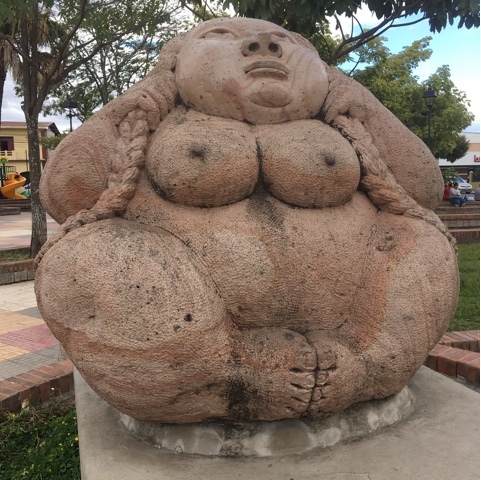
The Fat Lady ain't singing.
Another of the petroglyphs was the basis for this sculpture, located in the very fine central square. The square is the site of food vendors, lounging locals, and kids frolicking on the playgrounds. This is the spot from which to start any good Esteli walkabout. Located less than one hundred meters from the infamous Hotel Los Arcos, I crisis-crossed the square on most of my outings.
Esteli is situated in the northwest portion of Nicaragua, near the border with Honduras. It shares a political and cultural legacy with the liberal faction of the north, as opposed to the conservative faction of the south. It is another part of the Leon versus Granada history that has caused the country grief. During the Sandanista Revolution, grief came to Esteli in a big way.
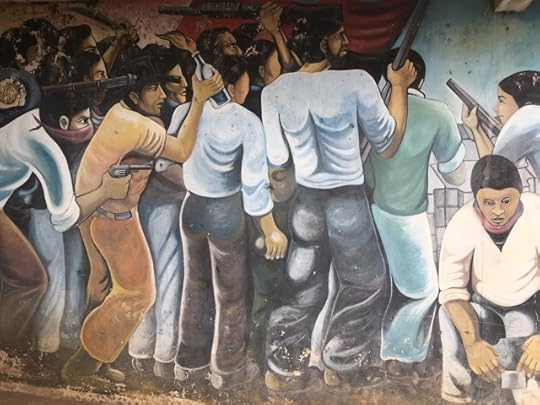
The Battle for Esteli
In 1978 and 1979 there was heavy fighting in and around Esteli. The forces of the government, the Somocistas, were fighting against the revolutionary Sandinistas. The Somocistas, the conservatives, were fighting to maintain the dictatorship of Antonio Somoza. They held a particular animosity for Esteli, which they considered a hotbed of insurrection. The city was shelled with artillery, bombed from the air, and assaulted with infantry. Over the course of the hostilities, about 15,000 people were killed. This includes young men who the Somocistas massacred, based on suspicions that they supported the revolution. Following the eventual victory of the Sandinistas, the city was rebuilt.
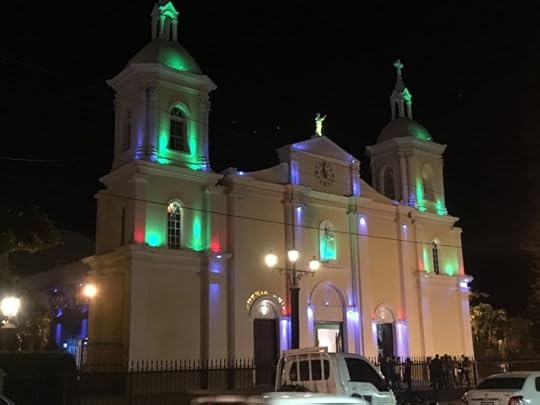
Ash Wednesday in Esteli
Esteli is a busy town. There are a great many jobs involving the industry that we will not name in this post. As a result of those worker's wages, Esteli is a thriving, busy, noisy mercantile center. Loudspeakers blare from shops, hawkers sell their wares on the street, and workers look for bargains in bins of clothing. It is all noise and color and frenetic energy. Venture off into the side-streets, however, and Esteli is a place of narrow lanes and sleeping dogs.
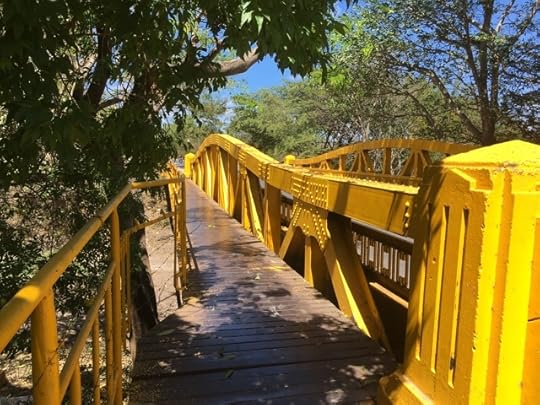
The Esteli River, dry as a bone.
If you like chicken, rice, and beans, you will love Esteli. Nicaraguan cuisine is not one that folks usually rave about. That you will get plantains with every meal is a given. Let's be kind and call the local grub earthy. Yes, that's it, earthy. And filling.
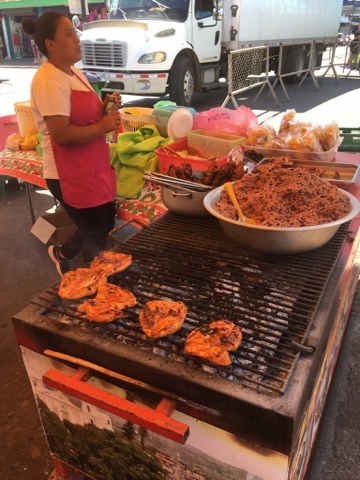
My favorite street-food stall.
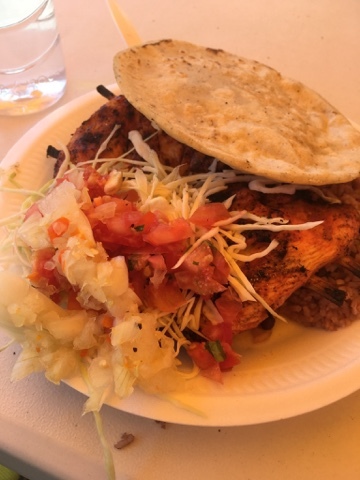
Pollo, hand-made tortillas, pico de gallo, and a smidge of slaw. What else do you need?
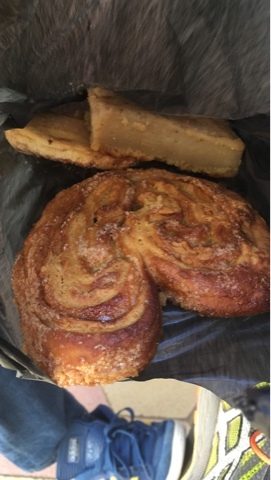
Still hungry? Heavy, sugary pastries are but a stone's throw away.
Speaking of the shops in Esteli, you may see someone wearing a T-shirt emblazoned with "New England Patriots -- Super Bowl Champions 2018." Wait, that's not right. But the Third World is where rejected clothing goes on to have new life. I have seen farmers in Laotian rice fields sporting shirts celebrating a Texas family reunion. How did such a shirt find its way here? The answer is simple: bulk clothing brokers. These folks buy up whatever rejected clothing they can find. The super bowl shirts printed for the losing team are a fine example. Bought for pennies a pound, the clothing, towels, whatever, are baled and shipped to other markets. Whole shipping containers of these bales end up in poor countries around the globe, where they are sold to folks who need cheap shirts.
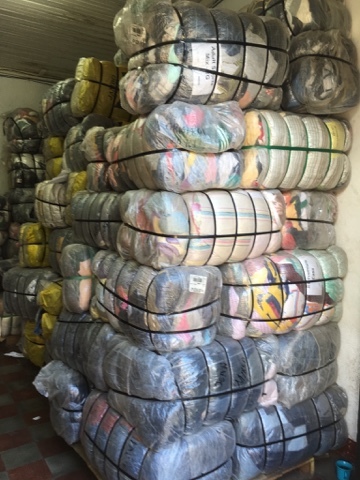
Bales of forgotten First World goods.
There is one reason why folks in Esteli are able to buy goods, and that one reason is the industry we are not mentioning in this post. The current population of Esteli is estimated at about 130,000 people. That is the polulation of the town. The department, or state of Esteli, is somewhere in the neighborhood of 230,000 people. In the city of Esteli, about half of the folks are directly employed in one industry. That industry makes you-know-what. Virtually every other business in the town provides goods, services, or material to that same industry.
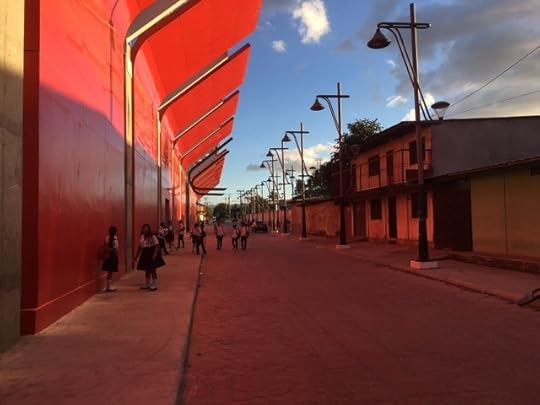
An evening walkabout can yield amazing sights. The gloaming of the day on a quiet Esteli street becomes, for a magic moment, a tableau of glowing red. Uniformed school children make their way home to dinners sure to contain a plantain. I stand mesmerized in the fleeting glow.
It is a pretty cool town. And I finished the post without mentioning you-know-what. Take that evil-voice-in-my-head. Until next time, and more of Nicaragua, Ciao for Now.
Published on February 20, 2018 16:41
Cigar-Town
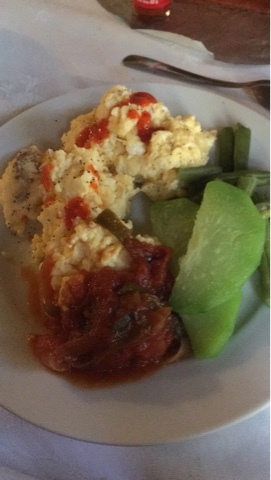
Brekkie Esteli, complete with green vege. Alert the Media!
The dining room of Hotel Los Arcos resembled an infirmary. I kept my morning chiperness in check so as not to be set upon by the sufferers. The story came out in bits and pieces, interrupted by multiple trips to the coffee urn. Zee Germans. Our group had met Zee Germans. It seems that the rules of engagement between our two cigar groups were these: 1) No Bottle Placed on Any Table May Remain Unopened2) The Engagement is NOT COMPLETE Until All Opened Bottles Are Emptied.
Our brave Bozos gave as good as they got, but there was a price to be paid and they were paying it. They had to pay it quickly, because the bus was due to sweep us up at 8:30 in the AM. Hi-Ho my poor beleaguered hearties, slug the Java down!
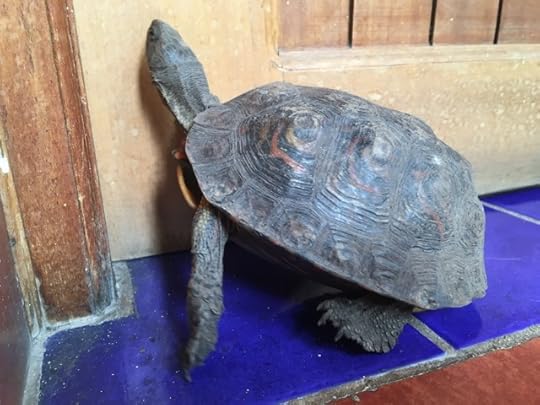
Do not manipulate the Tortugas! (No Manipular las Tortugas!)
Throughout its existence, Esteli has been a farming and trading town. An isolated village built in an ancient volcanic valley, time moved slowly in Esteli. That all changed with the coming of the Cuban Revolution. As the revolutionaries battled into power, some of the Cuban cigar-makers fled their island home. They took their tobacco seeds with them, hidden in the hems of their clothes, the bottoms of their bags, or in their socks. This Cuban diaspora fanned out across Latin America, searching for the proper soil in which to recreate their beloved tobacco leaves. In the rich, black volcanic soil of Esteli, the Cubans found what they were looking for. They began cultivating Cuban tobacco in the Esteli valley.
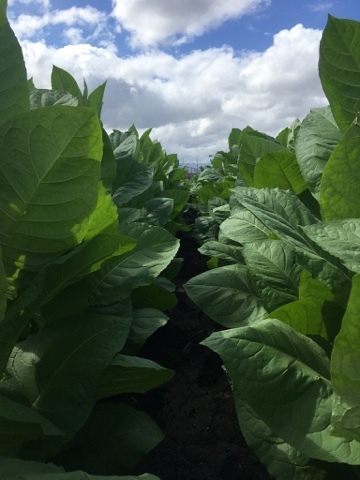
It's all about the Leaf. Tobacco, Esteli, Nicaragua.
The Bozos, both living and walking-dead, managed to make it onto the bus and out into the world. Our very first stop was one of the A.J. Fernandez farms. Start with the leaf Baby! We tripped around the greenhouses, saw the tiny tobacco seedlings, baked in the sun along the edge of the fields, ran our fingers along the lush surfaces of the tobacco leaves. For many of us, this was not the first rodeo. We had visited this very farm four years ago. In that time, great gauze nets have sprung up over some of the fields. Shade grown tobacco is becoming an important part of the Esteli crop.
For some folks it may seem that tobacco is just tobacco. It is a plant that folks smoke. And that would be true. But each region, and even each farm in that region, produces tobacco with certain distinct flavors, and strengths. Soil, weather, elevation, and type of seed all make a huge difference in the characteristics of the tobacco. Tobacco is harvested in what are called Primings. Where the leaf comes from on the plant has a huge impact on what the leaf is used for. Seco, the lowest leaves, burn well but have less flavor. Viso, the middle priming, has more flavor and strength than Seco. Ligero, the uppermost leaves, have the most strength and strong flavors, but they burn poorly. There is a lot more to this cigar business than sticking some tobacco leaf in a bunch and twisting it up.
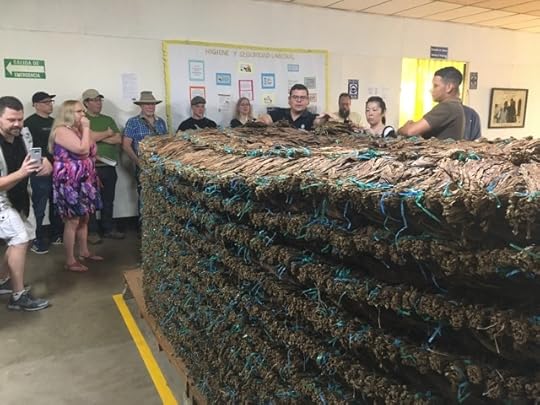
The Pillion
Reduced to the simplest processes, tobacco is turned from green leaf to smoking material in a series of steps. The leaves are harvested in Primings, then tied into 'Hands' of twenty-five leaves each. The hands are then hung in drying barns. When the tobacco hands are sufficiently dried, they have to be fermented to bring out the sugars and oils in the leaves. That process happens in the 'Pillion' which is a very carefully monitored compost heap. The hands of tobacco are rotated in the pillion from top to bottom and inside to outside. The temperature reaches up to 150 Fahrenheit. Too much heat and water and the tobacco molds or burns, too little and it can rot. It is a tricky business and I am making it sound far simpler than it is.
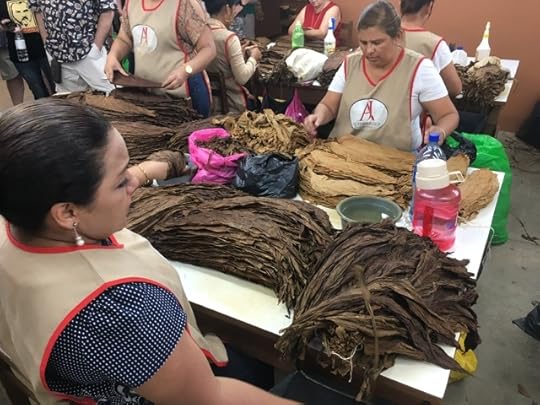
The Divas of Sorting
On its long journey, tobacco leaves are touched by many pairs of hands. The lowest estimate I have heard is three hundred individual folks. These are the hands that harvest, handle, wash, bunch or roll. It is harvested, hung in drying barns, fermented in pillions, rotated in the pillions, washed, shaken, de-veined, sorted, aged, re-sorted, and all of this before it ever sees the production floor. At each step, at each transport, it is carried by hand, washed by hand, sorted by hand. Labor is cheap in Nicaragua and machines take jobs away from people. Even at the loading dock, cartons of finished cigars are loaded into trucks by hand.
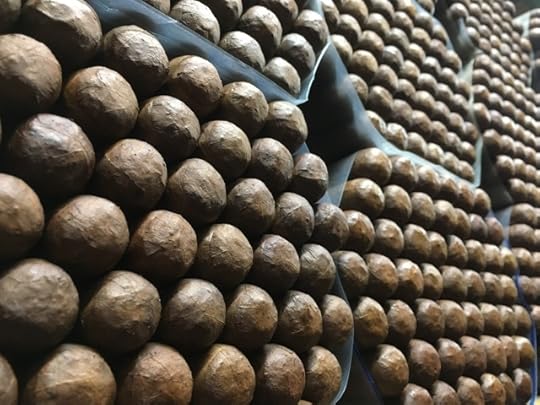
The final product nestled in the aging room.
Yes, yes, you say, but enough about the tobacco. How fare the Bozos? Ah, yes, the Bozos and Bozettes filed dutifully through farm and field. Some were eager and chipper at the front, some slow and suffering at the back. The off-gassed ammonia from the curing room brought watery eyes and coughing, but the brave Bozos shouldered on. Okay, in truth, some of them fled from the room like cowardly bunnies. But they were all standing at the end of the day.
We toured high, we toured low, we smoked cigars, we had lunch. By late afternoon our dogs were barking (which translates to sore feet for you civilians). Dinner concluded, it was time for camaraderie, cribbage, and cigars. For some of the more stubborn Bozos, it was also time for re-engagement with Zee Germans. Those poor rum bottles did not stand a chance.
And I retired to my room before being swept too far into the late-night madness. There was far more merriment to come and all of it at a price. Tomorrow would bring more shenanigans in Cigar-Town and I needed to be ready.
Published on February 20, 2018 06:24
February 19, 2018
Los Bozos van al Norte (The Bozos Go North)
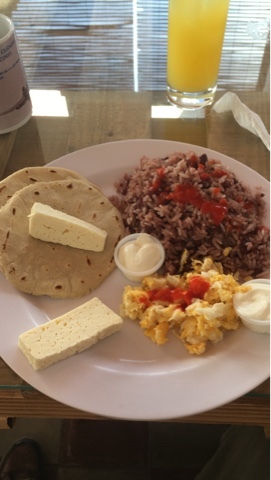
Pico de gallo, queso, huevos, y tortillas. What else does a hungry Bozo need.
Back in 2014, this same group of Bozos, plus or minus a few members, were assembled in Nicaragua. I suppose that makes this the Bozo Redux Tour. Regardless, we find ourselves here in Granada, Bozos and Bozettes. Today was a walkabout day before the long drive from colonial Granada in the south to the working city of Esteli in the north. Nicaraguan brekkie is the foundation of any good day of travel, and so we indulged before walkabout.
The day was hot and the sweat was rolling, perfect weather for a stroll. The whole Bozo cotillion assaulted the square. It was as if the US Marines were landing to protect the interests of United Fruit. We toured the cathedral, viewed the newly-painted frescoes, climbed the bell tower. One of the frescoes included an image of a panda bear, another a biblical fellow cradling a tiger, all painted in almost day-glo colors. It was a sight.
Given the option of a bus ride back to the hotel or a bit of walkabout, I chose to ambulate. A few stalwarts joined me, despite the heat. Down market and up cobbled hill, we serpentined our way back just to the hotel, arriving in time to load up for Esteli.
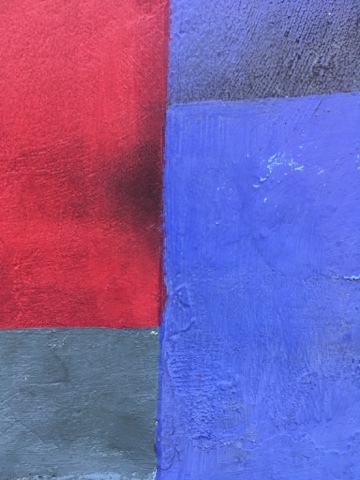
Paul Klee's Unknown Granada Period
Glorious patches of colonial chromatic color left behind, the Bozo Bus plowed north, past volcanoes, past lakes, past the skinniest horses in Central America. We smoked, we joked, we dozed. Yes, in Nicaragua one can smoke cigars on a bus. At least on our bus. Damn the torpedoes and New-Age panda savers.
We pushed past Managua (all roads lead to Managua) and continued north, beginning the climb into the mountains. Playing tag with the long-haul trucks on the Pan-American Highway, we ground along as best we could. The spleandor of colonial Granada had long since faded to the workaday reality of Nicaragua.
This is the poorest country in Central America. The nation is half the size of the US State of Nevada and supports a population of 6.2 million folks. NIcaragua has suffered at the hands of many. The Spanish Conquistidores, and the Haciendo system that followed, did much to shape Nicaragua. The country was absorbed into the First Mexican Empire in 1821, not becoming a sovereign nation until 1838. Civil wars wracked the country in the middle of the century, fought between the liberal north and the aristocratic south. It was Leon versus Granada. Nicaragua even suffered the indignity of William Walker, a Gringo, declaring himself president. Revolts were followed by counter-revolts, the heavy-handed tactics of United Fruit, and intervention of the US Marines to back the fruit corporation magnates. Trouble followed NIcaragua into the Twentieth Century, despite the yearnings of revolutionary poets and working people. The Somoza family made Nicaragua their own little piggy bank. The dictatorship was a family affair, continuing until the Sandanista Revolution in the late 1970's. The workers and campesanos of Nicaragua have never gotten an even break.
The Bozos on the Bus climbed higher into the mountains. By nightfall we had arrived on the outskirts of our destination. Esteli, once a dusty town on the Pan-American, now the cigar production Capitol of Nicaragua. There will be far more to tell about Cigar-Town, but for us it was a welcome sight. We rolled into the Hotel Los Arcos, infamous to all in the Nicaraguan cigar trade. Bags were stowed, bottles of rum unstowed, and general merriment unfurled. The rest of the night, well, what happens at the Los Arcos stays at the Los Arcos.
Besides, the Bozos are here for the week. There will be lots to tell, even if I have to give out the names of the innocent.
Published on February 19, 2018 17:50
Meeting the Tribe
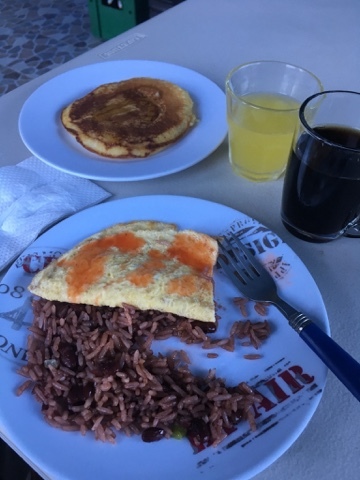
Breakfast Managua-Style
It was a lazy morning, a sitting around morning, a watching the birds morning. My airport transfer was at 11 AM, and I had no flight to catch. My only mission for the day was riding the short distance to the Augusto Sandino Airport to meet the incoming folks. Fifteen Bozos and Bozoettes reuniting for another tour of Nicaragua's cigar industry. Given that a dozen of us had done this prior, you'd think we would have learned our lesson.
And so it was a lazy morning, and verily I did sit around, eating, drinking coffee, smoking, and watching the birds. At the appointed hour, I loaded my crap in the little SUV and was schlepped over to the airport. We did not, however, go directly to the airport. There was an unscheduled stop when the GPS security sensor shut down the SUV 100 meters from the hotel. My driver had forgotten to flip the secret switch. Such are the small details of life in Managua.
We slipped from the quiet of the barrio to the chaos and cacophony of the Pan-American Highway. Dodging the death-dealing trucks and buses, we arrived safely. Now came the gauntlet of porters, taxi drivers, and tour shills.
"No, gracias, no necesito asistir." Again and again. The simple act of a porter laying a hand on a bag costs a buck. If another porter manages to lay a hand on your bag, that's another buck. If they have the opportunity, the happy porters will hoist your bag on their shoulders and parade it around, "Hail the Conquering Hero!" All the while your tab is running up. Falling into the clutches of the taxi-porter cabal can only be avoided with ninja-like skills. Fortunately, I have spent many years learning and perfecting this avoidance technique. I led them a merry chase, up and down, from arrivals to departures and back again.
I found the first of our party and we retreated to the far side of the airport road for a reunion and a cigar. The arrivals, from Seattle, Portland, Ecuador, and Nicaragua, were spread out over two hours. Eventually the cadre was complete, the bus arrived along with our Cigar Guru. We boarded the bus, Bozos One and All. The driver headed south, bound for the colonial town of Granada. The game was afoot.
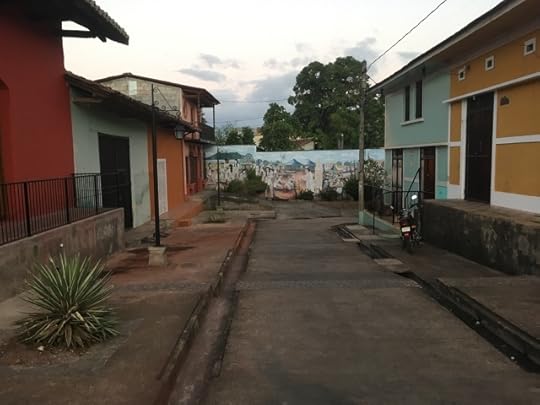
Granada Street Scene
Granada is a colonial city nestled onto the shores of Lake Nicaragua. Historically aristocratic and conservative, Granada is the rival of Leon to the north. While they once battled for control of Nicaragua, the two cites now battle for the tourist dollars.
Colorful cobbles streets, colonial plazas, Granada has what the tourists want to see. We arrived in the town, stowed out gear, and fell into a reunion of cigars smoking and tall tale telling. The opportunity for a walkabout was looming large. Two of us slipped out of the hotel and set about the streets.
The center of Granada is the cathedral and the central plaza. From there, a walking street leads down to the lake, threading past a throng of waiters waving menus. The cathedral and promenade serve to suck most of the touristas into a concentrated mass, thus rendering them very easy to avoid. Two blocks off of the main streets, we wandered through the early evening.
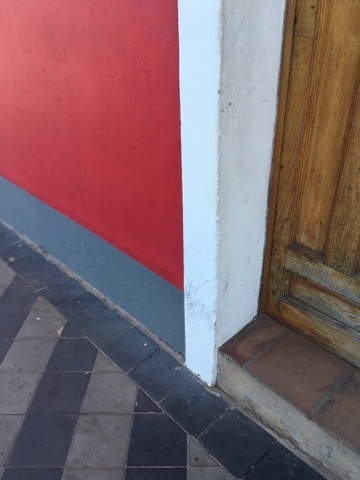
The Essential colors of Granada.
Tiles, cobbles, vibrant color, sun-blasted brick, that is the mosaic of a Central American colonial town. Mind your step while walking, lest you adorn your shoes with dog droppings or, worse, step into one of the many sneaky sidewalk holes. A late night stroll after a night of drinking can be a treacherous affair. Agility and awareness are requirements to survive a drunken stroll.
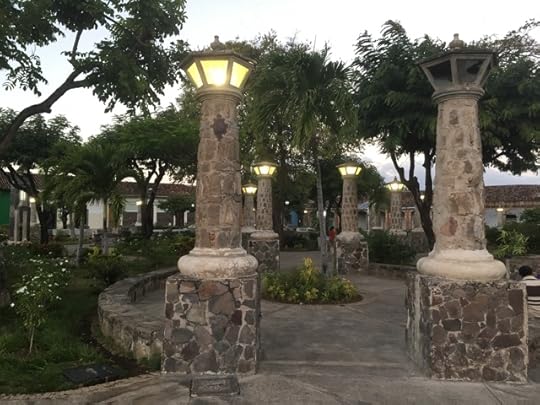
The Other Plaza
It was the gloaming when we found the other church, the working church. We watched the day slip away. On a hill above the tourist center, locals congregated, kids wobbled around on skates, hawkers sold ice cream and snacks. It was wonderful. We found a narrow passage down the hill into the old market, from where we eventually made it to tourist ground zero. Time to rejoin the Bozo Flock.
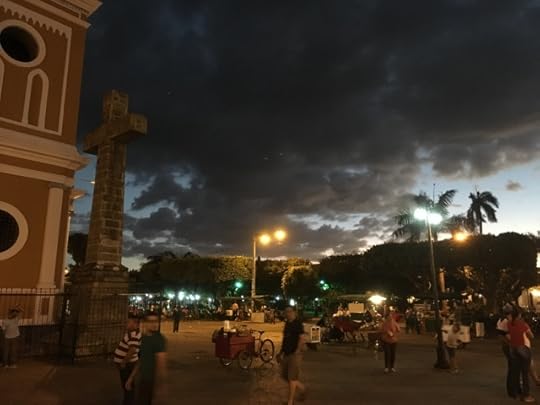
The Heart of Granada
We stepped out of the narrow market streets and into the buzz of the plaza. Nicaraguan Grackles were gathered in the trees, sending up a ruckus of chirps, squeals, and whistles. Tourists ran the gauntlet of craft stalls, some sporting fake Cuban cigars. Dodging the waving menus, we found our appointed cafe and settled in for a long, slow dinner. The street was a carnival of vendors, hawkers, and street perfomers, each trying to pry loose a bit of the tourist dollar. It was lovely.
Worn out from the flights, most of the Bozo crew retired early. A few hardy souls managed a good session of tall-tales and nightcaps. So it goes and so it went. The first night of another Bozo Tour came to an end.
Published on February 19, 2018 06:08



